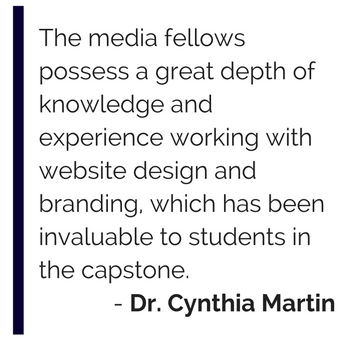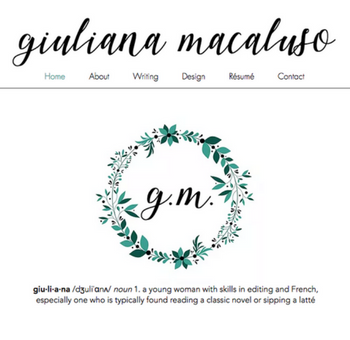Portfolios in the WRTC Capstone
Digital Communication ConsultingPreparing WRTC Grads for the Job Market
After years of working on projects and internships, students in the Writing, Rhetoric, and Technical Communication (WRTC) program are familiar with the frustration of showing their expertise and personality in a single page resume. When employers are potentially receiving hundreds of resumes, it’s difficult to know how to stand out from the crowd. To best prepare students for the job market, WRTC has offered a capstone to help its studentshowcase their skills, work samples, and experiences in an online portfolio. This semester, DigiComm tutor Jules Graham provided her expertise in professional online portfolios to assist Cynthia Martin’s WRTC 496 capstone course.

WRTC has been one of DigiComm’s closest and long-standing partners. “We’ve supported sections of the WRTC capstone since the start of DigiComm in 2014,” said Coordinator Paige Normand. The Media Fellow works directly with the class by giving presentations, hosting workshops, and offering one-on-one consultations to assist students through the creation of their professional online portfolios. This partnership was continued this year in Martin’s course with Graham. “I would come in every class and give a brief presentation on topics like web building platforms and the importance of personal branding, and helped guide them through what it means to make a good and productive portfolio,” Graham explained. “I loved being in front of the class, talking about those things that I’m passionate about and getting the class excited about how applicable the concepts are!”
Beyond a Resume
Online portfolios help the students showcase the expertise they have gained during their time at JMU beyond what a resume can. “I feel that people forget that a resume is not the only way to show what you’re capable of; a resume can only go so far,” said Graham. “A portfolio gives employers the chance to get to know you, what you’re about, who you are professionally, what you’re really capable of before they even meet you. There’s a lot of credibility and authenticity in showing what you have done.”
In addition to the digital portfolio itself, the Media Fellow provides students with additional skills, such as web design, graphic design, and personal branding. “In the sometimes cutthroat job market, knowing how to brand oneself is so important,” said Martin. “Jules was able to build confidence in students that they could and should brand themselves.”
Value of the Media Fellow
The Media Fellow also provides value to the WRTC program by bringing expertise in digital content creation. “The media fellows possess a great depth of knowledge and experience working with website design and branding, which has been invaluable to students
in the capstone,” said Martin. In return, working with programs like WRTC give the peer tutors invaluable experience. “The program has the potential to model peer teaching and collaborations, which is a skill that is very valuable in the workplace,” Martin continued.
“The thing about DigiComm is that you’re not telling students what to do, you’re giving them the tools and guidance for them to make their own choices,” Graham continued. “The students really surprised me with their portfolios, how different they all were, and how well they used the resources I game them and ran with it. It was so cool, and I was inspired myself by their work!”




